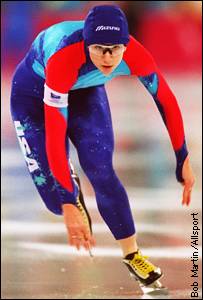

By Larry Schwartz
Special to ESPN.com
The story of her March 18, 1964 birth sounds like a fairy tale. The heroine's dad, Charlie, who had fathered four speed skaters among his five children, decided it would be better if he took the kids to a meet while mom gave birth. Charlie, the timer at the meet in Yonkers, N.Y., heard the public-address announcer tell the crowd, "It looks like Charlie's family has just added another skater."
That baby became the fastest U.S. speed skater who ever lived.
 | |
| Bonnie Blair pumps her way to the 500-meter gold medal in the 1994 Olympics at Lillehammer. |
She has gotten quite a few since, especially at the Olympics. Circling the globe, from Calgary to Albertville to Lillehammer, she picked up souvenirs that no other woman from the United States possesses. While diamonds are rumored to be a girl's best friend, Blair prefers gold, as in five Olympic gold medals.
No woman had ever won consecutive 500-meter speed-skating championships at the Olympics before Blair won three straight. The 5-foot-4, 130-pounder also captured two 1,000-meter titles. And through all the championships, Blair kept the same hat size.
"Bonnie doesn't know she's a celebrity," said her mother, Eleanor. "She sees herself as a regular person."
After being born in Cornwall, N.Y., Blair moved with her family to the Midwest and was raised in Champaign, Ill. She took to speed skating like her older siblings. But while skating eventually became secondary to them, Blair decided as a teenager to dedicate her life to the sport.
If Blair were going to make the 1984 Olympic team, she knew she would have to train in Europe. The trip was made possible when the Champaign Policemen's Benevolent Association donated the entire amount, $7,000. In Sarajevo, competing as an unknown in her first Olympics, she finished a respectable eighth in the 500. She was only 19.
Four years later, she not only won her first Olympic gold, she set a world record, blazing around the 500-meter oval in 39.10 records. A jeweler in Champaign fashioned a necklace for her out of 39 jewels. She became the only double medalist for the U.S. at these Games by capturing the bronze in the 1,000. About 30 members of the Blair Bunch -- family and friends of Bonnie's -- traveled to Calgary to cheer her.
 |
|
| Previous poll results |
"Her long strides make her the best technician in the world over the sprint distance, man or woman," said U.S. coach Peter Mueller, the 1976 Olympic champion in the 1,000 meters. "She's really dynamic; she gets everything out of her stroke. It's like she was born on ice."
Blair raced the 1,000 in 1:21.90, but there were no high fives or raised arms from the exhausted skater, as she had done immediately after her 500 race. The gold medal still hadn't been decided. She sat on a bench near the starting line to watch the rest of the competition. It was with relief that she saw Ye Qiaboco of China finish a mere two hundredths of a second behind her time. Blair had her second gold of the Games.
She won the Sullivan Award in 1992 as the United States' top amateur athlete.
More than 60 of the Blair Bunch traveled to Lillehammer, Norway, in 1994 to see history. "A lot of people think that I'm under a lot of pressure with my family and friends spending all that money to follow me," Blair said. "But they don't care whether I win or lose. They'd come anyway because we're one big family that's having lots of fun."
Blair had the most fun when she added to her gold collection by winning her third straight 500, finishing in 39.25 seconds, a whopping 36-hundredths of a second ahead of the runner-up. She had become so comfortable on the podium that she happily sang along with the national anthem.
But still she needed one more victory -- in the 1,000 meters -- before she could leave four-time gold medalists Evelyn Ashford, Janet Evans and Pat McCormick in her rear-view window. Blair went all out for 600 meters and then held on the rest of the race. Her time was 1:18.74, and she won by a whopping 1.38 seconds, the largest margin in Olympic history for the event.
There still was one goal Blair wanted to attain. She had always wanted to beat 39 seconds in the 500. She accomplished it in March 1994, with a 38.99 in Calgary to become the first woman to break the 39-second barrier. Blair went even faster on Feb. 12, 1995, also in Calgary. She blazed to a 38.69, helped by the 38.94 that Canada's Susan Auch skated in the same pairing.
Blair exited at the peak of her powers. On her 31st birthday (March 18, 1995), she had a personal best and set an American record with a 1:18.05 in the 1,000 meters. It was her last race.
Now retired from skating, Blair, who married Olympic teammate Dave Cruikshank, earns a living as a motivational speaker to corporations and associations. She also donates her time to a variety of charities that she organizes through the Bonnie Blair Charitable Fund.

